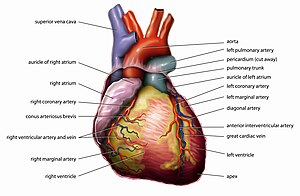The heart is a myogenic muscular organ found in all animals with a circulatory system (including all vertebrates), that is responsible for pumping blood throughout the blood vessels by repeated, rhythmic contractions. The term cardiac (as in cardiology) means "related to the heart" and comes from the Greek καρδιά, kardia, for "heart".
The vertebrate heart is composed of cardiac muscle, which is an involuntary striated muscle tissue found only in this organ, and connective tissue. The average human heart, beating at 72 beats per minute, will beat approximately 2.5 billion times during an average 66 year lifespan. It weighs approximately 250 to 300 grams (9 to 11 oz) in females and 300 to 350 grams (11 to 12 oz) in males.[1]
In invertebrates that possess a circulatory system, the heart is typically a tube or small sac and pumps fluid that contains water and nutrients such as proteins, fats, and sugars. In insects, the "heart" is often called the dorsal tube and insect "blood" is almost always not oxygenated since they usually respirate (breathe) directly from their body surfaces (internal and external) to air. However, the hearts of some other arthropods (including spiders and crustaceans such as crabs and shrimp) and some other animals pump hemolymph, which contains the copper-based protein hemocyanin as an oxygen transporter similar to the iron-based hemoglobin in red blood cells found in vertebrates.
In the adult fish, the four chambers are not arranged in a straight row but, instead form an S-shape with the latter two chambers lying above the former two. This relatively simpler pattern is found in cartilaginous fish and in the ray-finned fish. In teleosts, the conus arteriosus is very small and can more accurately be described as part of the aorta rather than of the heart proper. The conus arteriosus is not present in any amniotes, presumably having been absorbed into the ventricles over the course of evolution. Similarly, while the sinus venosus is present as a vestigial structure in some reptiles and birds, it is otherwise absorbed into the right atrium and is no longer distinguishable.[8]
The vertebrate heart is composed of cardiac muscle, which is an involuntary striated muscle tissue found only in this organ, and connective tissue. The average human heart, beating at 72 beats per minute, will beat approximately 2.5 billion times during an average 66 year lifespan. It weighs approximately 250 to 300 grams (9 to 11 oz) in females and 300 to 350 grams (11 to 12 oz) in males.[1]
In invertebrates that possess a circulatory system, the heart is typically a tube or small sac and pumps fluid that contains water and nutrients such as proteins, fats, and sugars. In insects, the "heart" is often called the dorsal tube and insect "blood" is almost always not oxygenated since they usually respirate (breathe) directly from their body surfaces (internal and external) to air. However, the hearts of some other arthropods (including spiders and crustaceans such as crabs and shrimp) and some other animals pump hemolymph, which contains the copper-based protein hemocyanin as an oxygen transporter similar to the iron-based hemoglobin in red blood cells found in vertebrates.
In fish
Primitive fish have a four-chambered heart, but the chambers are arranged sequentially so that this primitive heart is quite unlike the four-chambered hearts of mammals and birds. The first chamber is the sinus venosus, which collects de-oxygenated blood, from the body, through the hepatic and cardinal veins. From here, blood flows into the atrium and then to the powerful muscular ventricle where the main pumping action will take place. The fourth and final chamber is the conus arteriosus which contains several valves and sends blood to the ventral aorta. The ventral aorta delivers blood to the gills where it is oxygenated and flows, through the dorsal aorta, into the rest of the body. (In tetrapods, the ventral aorta has divided in two; one half forms the ascending aorta, while the other forms the pulmonary artery).[8]In the adult fish, the four chambers are not arranged in a straight row but, instead form an S-shape with the latter two chambers lying above the former two. This relatively simpler pattern is found in cartilaginous fish and in the ray-finned fish. In teleosts, the conus arteriosus is very small and can more accurately be described as part of the aorta rather than of the heart proper. The conus arteriosus is not present in any amniotes, presumably having been absorbed into the ventricles over the course of evolution. Similarly, while the sinus venosus is present as a vestigial structure in some reptiles and birds, it is otherwise absorbed into the right atrium and is no longer distinguishable.[8]

